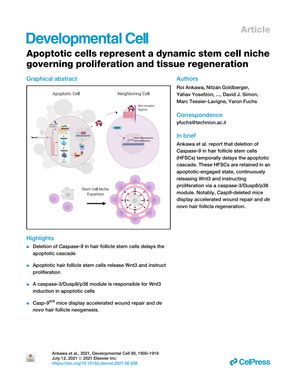Apoptotic Cells Represent a Dynamic Stem Cell Niche Governing Proliferation and Tissue Regeneration
June 2021
in “
Developmental Cell
”

TLDR Dying cells can help with faster healing and new hair growth by releasing a growth-promoting molecule.
The document details a study investigating the role of caspase-9 in hair follicle stem cells (HFSCs) and its effects on apoptosis, proliferation, and tissue regeneration. The study found that deletion of Caspase-9 in HFSCs delays apoptosis, causing these cells to remain in an apoptotic-engaged state and continuously release Wnt3, a molecule that promotes cell proliferation. This leads to accelerated wound repair and the ability to regenerate new hair follicles in mice. The study also identified a caspase-3/Dusp8/p38 module that induces Wnt3 in apoptotic cells, suggesting that apoptotic cells can serve as a dynamic stem cell niche. The findings provide insights into the potential of manipulating apoptotic pathways to enhance regenerative processes. The study involved experiments on mice (with at least 3 mice used in in vivo experiments and 3 pooled mice for flow cytometry) and in vitro cell cultures, although the exact number of cell culture replicates is not specified in the summary.








